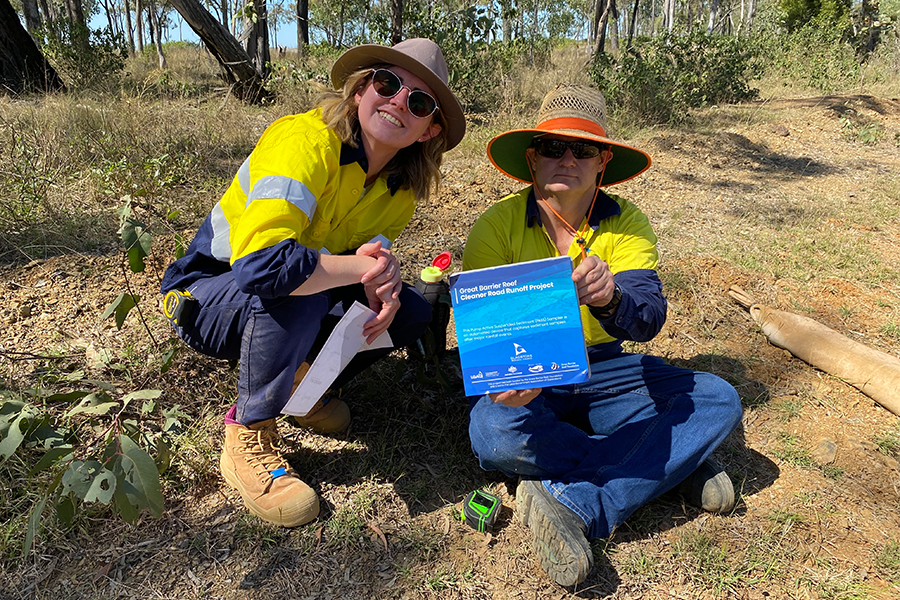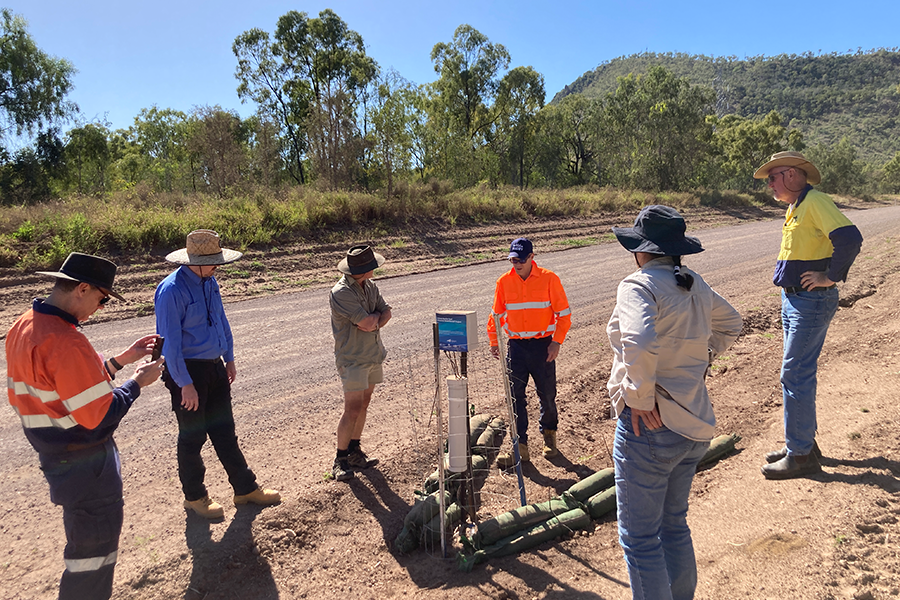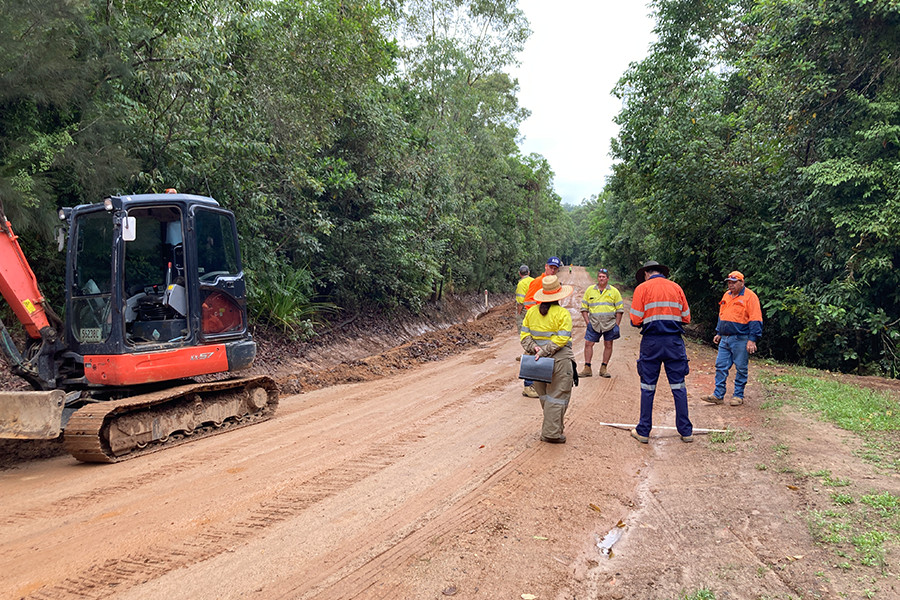By Megan Forrest, LGAQ Project Manager – Cleaner Road Runoff
Thousands of kilometres of unsealed road networks are potentially causing significant damage to our beloved Great Barrier Reef and local governments have come together to contribute to its protection.
The problem
Local government manages over 38,000 kilometres of unsealed road within the Reef catchment that are prone to erosion, particularly during the wet season, contributing to gully erosion and increased sediment loads in waterways. On average, it is estimated that unsealed pavements lose the top 25mm of pavement material each year. This loss can vary depending on traffic volumes (particularly heavy vehicle movements), material and weather.
A considerable sediment load is potentially generated when this tonnage per kilometre is equated to the lineal kilometres of unsealed roads that are within the Reef catchments in Queensland. Many of these roads will remain unsealed as they do not attract the volume of traffic to justify sealing.
These roads are subject to regular maintenance and grading that requires access to gravel from the nearby environment and the movement of materials to improve road conditions. Traffic movement distributes dust from the road surface and heavy rain can wash out road surfaces.
More frequent extreme weather events associated with climate change will increase the likelihood of significant damage to unsealed roads with environmental, economic and community connectivity impacts. Sediment has a significant impact on the health of a coral reef, although the link between it and the health of the Reef may not always be obvious.
When sediment particles being carried in water (suspension) eventually drop out and settle to the ground, the process is called sedimentation. Really fine sediment is made up of silt and clay (<20μm). Nutrients and other pollutants attached to sediments have the potential to be released into the marine environment and create problems for coral and seagrass.
Much of the sediment that is washed to the Reef is very fine and can stay suspended in the water for a long time, often travelling a great distance away from or along the coast. It causes turbidity (the water loses its transparency and looks murky or muddy), which leads to reduced light for seagrasses and coral, and can reduce their growth if present for extended periods.
Scientists now know that high concentrations of suspended sediment can interfere with filter feeding by organisms such as clams, reduce coral recruitment, alter the quantity and quality of light available for photosynthesis—essential for growth of coral and plants such as seagrass—and even smother corals.
In some areas, turbidity can reduce light penetration for days, weeks or even months. Fine sediment can remain in inshore areas for decades, making it available for winddriven resuspension, which causes ongoing coastal turbidity.
Sediment can also affect the reproductive cycle and early development of coral and some species of fish, and damage gills.

LGAQ Project Manager - CRRO Megan Forrest with Brent Tangey from Gladstone Regional Council installing PASS samplers
The project
Recognising the importance of local governments’ ongoing role in protecting the Reef, the work being undertaken already and the opportunities to consolidate and accelerate progress, the LGAQ sponsored the development of the Reef Councils’ Rescue Plan (RCRP) proposal.
The Cleaner Road Runoff (CRRO) project is one of the three key initiatives detailed in this plan.
The project seeks to improve water quality outcomes for the Reef by measuring the impact of sediment runoff from the 38,000-plus kilometres of unsealed road network located within the Great Barrier Reef catchment.
Road drainage design and management practices are also being trialled to work towards establishing best practice examples for road managers across the region.
By being part of the CRRO project, councils are paving the way to identifying new design and management practices that can be implemented right across Queensland.
This year, the LGAQ team, in partnership with the Great Barrier Reef Foundation, launched the CRRO Project with Gladstone Regional Council and Whitsunday Regional Council. Based on the success of the project in its initial stages, the project has secured an extension until May 2024 with additional funding of $1 million.
This extension will allow the project to expand this important study to three additional councils: Cassowary Coast Regional Council, Isaac Regional Council and Bundaberg Regional Council. Each of the councils involved in the project is providing significant in-kind contributions through involving their road teams to set up drain profiles for the study, with their environmental teams providing significant manpower to collect sediment samples in large rain events.
The participants
Collectively the councils involved in this project manage over 6,000 kilometres of unsealed roads and represent four Great Barrier Reef catchments (Fitzroy, Burnett Mary, Wet Tropics and Mackay Whitsundays). Each of these councils has unique characteristics of sediment generation across their road networks, helping this research project to develop a risk framework of sedimentgeneration factors that will be fit-for-purpose across various areas in the Reef catchments.
The LGAQ is working with Strategic Environmental and Engineering Consulting (SEEC) and Joseph Consulting who are leading the technical and scientific elements of the project.
In addition to the participating councils and consultants, the project is led by a Project Advisory Committee made up of council representatives, Institute of Public Works Engineering Australasia, Queensland, Griffith University, Office of the Great Barrier Reef and AECOM.

Whitsunday Regional Council project team discussing study segment on Strathmore Road
Case studies
Ragland Station Road, Gladstone Regional Council
Gladstone Regional Council (GRC) commenced the Cleaner Road Runoff study in early 2022.
To date, the Ragland Station Road site has been able to collect sediment runoff data across four rain events, providing the initial indication that unsealed roads are contributing large volumes of sediment. (It is noted however that more data sets are required across all study sites to make more robust conclusions.)
Ragland Station Road is approximately 18 kilometres in length and has seven PASS samplers (eighth sampler to be removed) installed in various locations, along with a rain gauge and two dust monitoring stations.
Through their efforts, GRC is a champion in the project, sharing key insights and approaches with the councils who have just joined the project. Additionally, the team has been crucial in the work with Griffith University to make the PASS sampler equipment more cattle resistant (with many of the local cows in both Gladstone and Whitsunday enjoying the taste of sampling tubes!).
In mid-August, the project team visited the site with the council’s environmental team to refine site locations and methodologies before the upcoming wet season.
Cassowary Coast Regional Council – site set up
In late August, the project team visited Cassowary Regional Council to work with road and environmental teams to identify suitable segments along Granadilla Road.
This 10-kilometre stretch provides a good representation of roads within the council’s unsealed road network. During the visit, the project team worked with Brendan Slattery and Chris Accatino from Cassowary Coast Regional Council to set up the live monitoring rainfall station and water logger equipment. These pieces of equipment will support in collecting data to model flows and velocities in the drain profiles.

Working with CCRC crew to measure and identify suitable drain locations for sediment runoff capture
The future
The project has continued to grow, with the additional funding allowing for more councils across Queensland to participate. Through ongoing advocacy efforts, the team has also commenced several discussions with various funding bodies to identify future funding and implementation opportunities.
Overall, the team is hopeful that a project at this large scale will help create communities that actively protect the Reef whilst also opening opportunities to improve their local unsealed road networks.
Key next steps for the project include working with all the councils to capture more sediment samples in the next wet season as well as commence work on a more comprehensive communication and training program for implementation in 2023-24.
Through innovative and collaborative approaches to unsealed road and drainage management practices, councils are building significant pathways to reduce impact on the Reef.